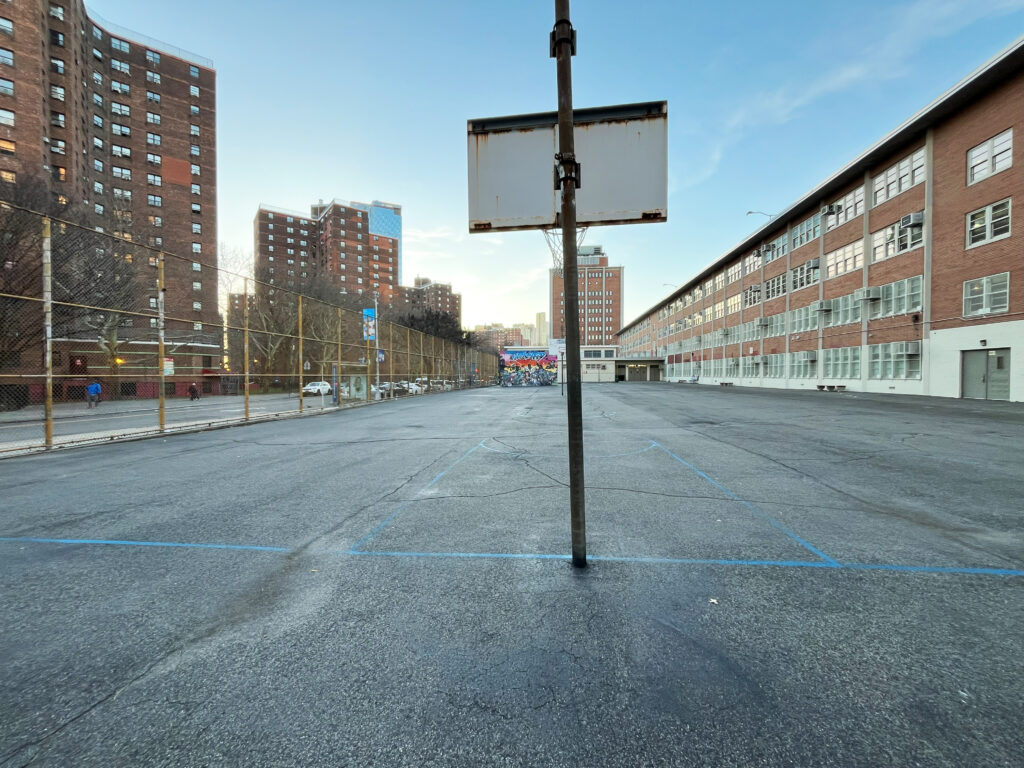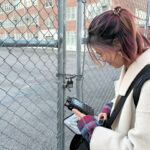Across New York City, workers are tearing out concrete and asphalt from schoolyards and replacing them with rain-absorbing surfaces that are more climate resilient. The redesigning of playgrounds in immigrant neighborhoods offers a once-in-a-lifetime opportunity to rethink how kids in the city relate to the outdoors.
Producer Aria Young, an immigrant journalist from China, explores the recent transformation of New York City playgrounds in response to the climate crisis and what it means for children’s play.
NYC school playgrounds find new ways to weather the storm
by Aria Young
Cracked blacktop, rain puddles, and potholes: the conditions of many New York City public school playgrounds are not ideal ingredients for a playful childhood. At Corlears, an education complex comprising three schools on the Lower East Side of Manhattan, an outdated schoolyard is getting a makeover.
“There’s pit holes in the ground. There’s cracks where anybody can slip and fall,” said 17-year-old Dyonis Diaz, a senior at Orchard Collegiate Academy and Vice President of the Student Council. “…when you look at [our schoolyard], it kind of just falls out of place.”
New York schoolyards are becoming more dangerous as climate threats intensify. Concrete and asphalt surfaces are not water-absorbent. In rain storms, most playgrounds can create surface runoff and cause flooding. During heat waves, these playgrounds can overheat easily, raising surface temperature by as much as seven degrees.
The city has seen significant consequences from extreme weather events in recent decades. Heat waves cause over 13 heat stroke deaths annually, according to NYC Mayor’s Office of Resiliency. The New York City Panel on Climate Change (NPCC) reported that the city’s sea level has risen 1.1 feet from 1900 to 2013, nearly twice the observed global rate.
Corlears is located by the East River near the floodplain. In October 2012, Hurricane Sandy devastated the neighborhood, leaving its streets 14 feet under water. Now, the Lower East Side community is a battleground for the city’s climate adaptation efforts as residents fight over resiliency plans for East River Park, a vast waterfront green space in the area.
While the neighborhood grapples with the climate crisis, Corlears’s schoolyard is in development to be transformed. The Trust for Public Land (TPL) is a nonprofit organization that works in partnership with the Department of Education to renovate outdated schoolyards and turn them into climate-resilient playgrounds. Since 1996, the TPL has transformed over 220 playgrounds in New York, bringing green infrastructure to communities across the five boroughs.

(From L to R) Dyonis Diaz, Na-Jaya Dunlap, and Assiatou Diallo are students on the playground design committee standing in front of a vision board for their new schoolyard. Photo credit: Aria Young.
TPL designs playgrounds with a committee of students, leading them through a ten-week curriculum integrated with the design process. At Corlears, the students have chosen to prioritize flood prevention by building a permeable turf field that can absorb tons of rainwater in a storm.
“We teach them about the problem with combined sewage overflow in New York City,” said Tiffany Briery, a program manager at the TPL. “Even though it’s a playground they’re designing, they’re actually creating change citywide to help with a pollution problem.”
Just two blocks away from Corlears, P.S. 184M Shuang Wen School has gone through a similar process. In 2019, Shuang Wen’s playground was renovated by TPL, after being underwater during Hurricane Sandy. Their new $1.7 million playground features infiltration basins under an artificial turf, a green roof gazebo, a student-run rain garden, and much more.
Nine years after Hurricane Sandy, Shuang Wen’s new playground successfully weathered Hurricane Ida, which claimed the lives of 13 people in New York City.
“There was not even a puddle after the tremendous amount of rain that we had,” said Mary Alice Lee, TPL’s New York City Playgrounds Director in a City Limits report.
The Corlears Complex started playground construction in February 2024. The new playground will feature a volleyball court, a basketball court, a playset, and numerous trees to provide shade in hot weather.
While green playgrounds have proven effective in improving resiliency during climate-related events, many public schools and playgrounds do not have the privilege of renovation. Some lower-income neighborhoods lack access to green space to begin with. In so-called “playground deserts,” residents have no outdoor play areas easily accessible from their homes.
According to former New York City Comptroller Scott M. Stringer’s report, New York City ranks 48th in playgrounds per capita among the 100 largest American cities as of 2019. Brooklyn is the most underserved borough, with only eight playgrounds for every 10,000 children under the age of ten.
“Going outside and being able to walk, it’s a sense of relief,” said 15-year-old Assiatou Diallo, a sophomore on the student design committee. “Because staying home all the time and watching Netflix, it gets tired and lonely… You create memories outside with people.”
By the end of the century, the city could experience as much as 25% more rainfall and 1.5 times as many extreme rainy days, according to the NPCC. Without climate-resilient infrastructure, outdated public school playgrounds continue to be some of the most vulnerable areas in the city.
However, protecting green spaces is hardly a priority to city officials. This year, the city’s budget for parks and playgrounds is $41.5 million less than last year’s. Less than 1% of the city’s total budget goes to parks and playgrounds—a significantly smaller percentage compared to other major cities in the U.S..
“This is not just a one-and-done deal, is it?” said Miles Doyle, Orchard Collegiate Academy Principal. “This is not going to solve climate change. This is one part of it.”
Credits
Hosted by Iggy Monda
Story Produced by Aria Young
Edited by John Rudolph, Quincy Surasmith, and Iggy Monda
Fact Checking by Julie Schwietert Collazo
Engineering by Jocelyn Gonzales
Theme music by Fareed Sajan
Additional music: Pure Hazel by Frank Jonsson
“Home, Interrupted” show logo by Daniel Robles
Feet in 2 Worlds is supported by the John D. and Catherine T. MacArthur Foundation, The Ford Foundation, the David and Katherine Moore Family Foundation, the Fernandez Pave the Way Foundation, an anonymous donor, and contributors to our annual NewsMatch campaign.




